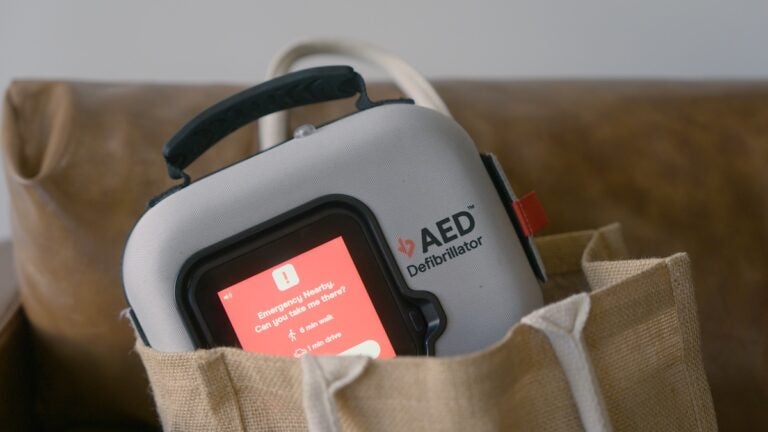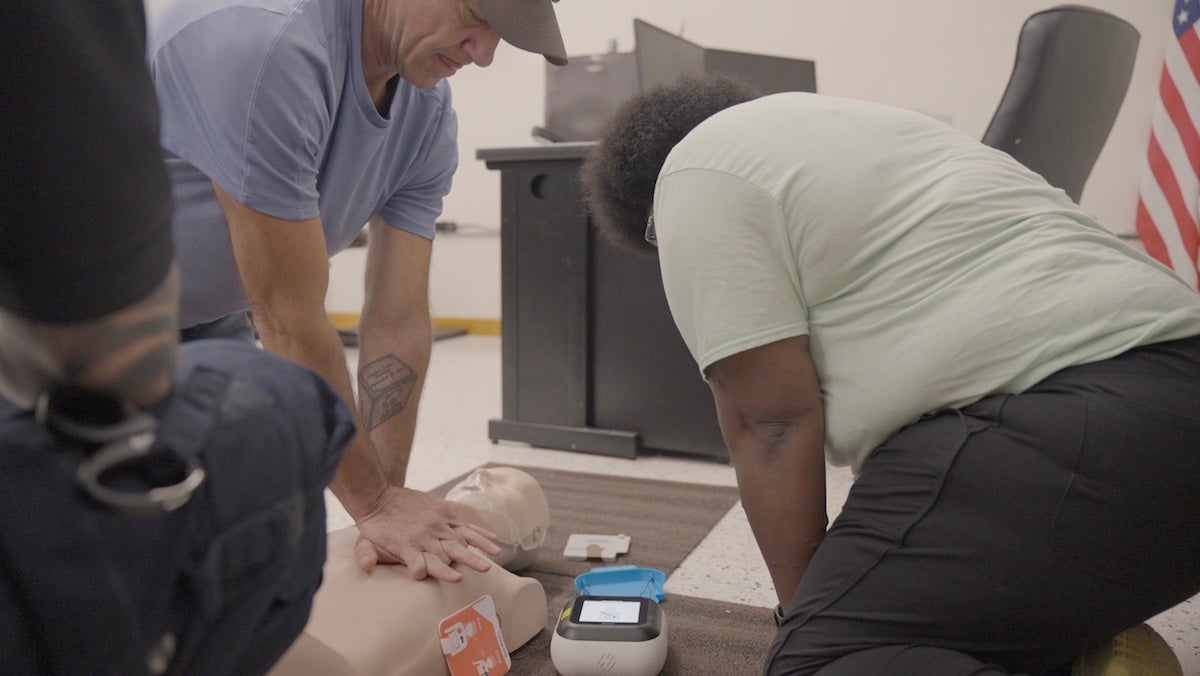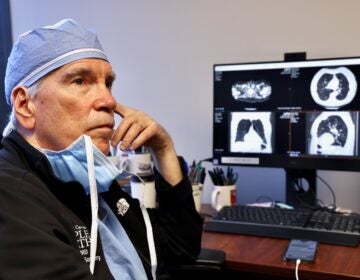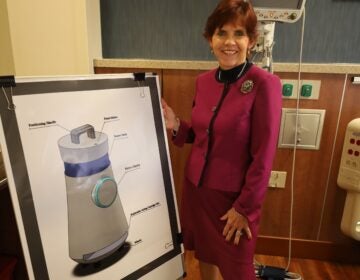New generation of AEDs designed to reach cardiac arrest victims faster
Surviving cardiac arrest is rare. Only about 10% of patients pull through. One major factor is getting CPR immediately. New AEDs could help speed things up.
Listen 10:13
An automated external defibrillator (AED) is a medical device that evaluates a person's heart rhythm and delivers an electrical shock to help restore a normal rhythm during cardiac arrest. (Courtesy of Avive Solutions)
This story is from The Pulse, a weekly health and science podcast.
Find it on Apple Podcasts, Spotify, or wherever you get your podcasts.
Saturday, Sept. 13, 2014, almost ended up being Jaclyn McGlone’s last day alive. She woke up feeling sluggish and tired, but she pulled herself together to go coach a girls’ soccer team in a suburb of Philadelphia. When she got to the field the girls started their practice, a few other teams were having matches nearby. McGlone felt really out of it, not herself. Then she collapsed.
At just 30 years old, she had suffered a heart attack and cardiac arrest. The girls on the soccer team, who were between the ages of 11 and 12, didn’t know what was happening.
“They went into panic mode,” said McGlone. “But they got help right away. They’re a great group of girls!”
The girls screamed for help and just by chance an ER doctor happened to be nearby. Her son was playing on the field next to where McGlone’s team was practicing. “She came right over, and did immediate resuscitation. Having somebody who knew exactly what to do within seconds of me going into cardiac arrest is the most important thing that happened in my line of recovery.”
When the ambulance arrived the medics shocked Jaclyn’s heart to restart it. Medics had to shock her again on the way to the hospital. From there, it was touch and go with a lot of ups and downs.
McGlone stayed in the hospital for three weeks and at an in-patient rehab for over a month, but she made a full recovery. She is 40 now and has had two children since her heart attack. She is doing well.
Her doctors were never able to determine why she had suffered cardiac arrest at such a young age, especially since she was perfectly healthy before.
McGlone hasn’t really dwelled on what happened, why it happened, and all of the what ifs. But she’s grateful that the right people were there to help her when she collapsed.
“How fortunate I was that the [response] chain worked exactly the way it’s been prescribed by medical professionals upon cardiac arrest.”
Increasing the odds of survival
Surviving cardiac arrest is rare. Only about 10% of patients pull through. For those who do, luck is a big factor.
“Cardiac arrest is one of the most time-sensitive diseases in all of medicine. For every minute that cardiac arrest is not treated, the chance of survival drops by 10 to 15 percent,” said Benjamin Abella, an emergency physician who heads the department of emergency medicine at the Icahn School of Medicine at Mount Sinai.
One major factor when it comes to survival is getting CPR immediately.
“You have to move blood. Without CPR, survival is very unlikely,” said Abella. “When someone experiences cardiac arrest, there’s no blood flow throughout the body. The heart is stopped and there is no perfusion of the brain or other vital organs, which is why people go immediately unconscious. The act of CPR, which is pushing rhythmically on the center of the chest at a certain rate and depth, that generates blood flow. It’s not restoring life, but it’s buying time.”
In some places in the U.S., survival rates after cardiac arrests have increased to 20 or even 30 percent. Abella says that is a goal to shoot for. “These are cities that have put a lot of effort into bystander CPR training, into placement of defibrillators around their communities.”
Automated external defibrillators, or AEDs, are devices that administer electric shocks to restart the heart.
“The defibrillator shocks the heart, which stops everything for a brief moment and allows it to restart,” said Abella. “But it has to be done early in the first few minutes.”
AEDs have become far more common in the last decade, after a big study found that public access to these devices ups the chance of survival. But Abella says the work doesn’t end there.
One big issue is a lack of awareness. He says many people don’t know what these devices are for, or who is supposed to use them in case of emergency.
“We’ve done studies of this and asked people, ‘What is this device that we’re pointing at and what is it for?’ And many people had no idea. And even among the people who knew what an AED was, many of them then said, ‘Well, that’s for when the ambulance crew gets here. That’s not for us.’”
Subscribe to The Pulse
Abella says AEDs are designed to be easy to use. “When you open them up, they talk, they will coach you through the steps. There’s usually two or three buttons only. And it will say, ‘push this button, then push this button.’ So they’re very, very explicit. And they’ve gone through extensive testing, specifically, to be used under stress by people with no training.”
Another problem is that the AEDs are passive. “Historically, AEDs have been devices that sit on the wall and wait for someone to use them, much like fire extinguishers. It doesn’t have Wi-Fi. It doesn’t alarm. You have to know where it is and then grab it.”
Creating a new generation of AEDs
We live in a world where you can locate your smartphone, track your pizza delivery, and see exactly where a package is on a map. A company called Avive Solutions is applying the same technology and idea to a new generation of AEDs.
“We take the incredible advent of technology and location tracking and cellular connectivity and use that to help save the lives of our neighbors, and of the people that we love the most,” said Meir Berkman, vice president of strategy and business at Avive.

Avive’s AEDs only weigh about 2 pounds and they’re small enough to fit into a backpack. They’re designed more to look like a consumer electronic, rather than a medical device, so that people feel comfortable using them. They have a big screen on the front and they’re connected to crisis response centers. The person answering the 911 call can activate the AEDs closest to the emergency. The AED turns on, and gives verbal cues to bystanders to pick it up and bring it to the location of the emergency.
Avive also wants to expand the availability of AEDs.
“We’re actually partnering with communities to put AEDs into the hands of civilians who are willing to help their neighbors,” said Berkman. “The vast majority of cardiac arrests are actually happening in people’s homes,” he said. “And so in addition to putting the AEDs in the airport, the shopping mall, the coffee shop, the locations where we tend to see the devices, we’re also deploying AEDS into the hands of civilians who are willing to help their neighbors.” Avive calls this concept “4-Minute Cities,” with the goal of having an AED on location within four minutes of somebody collapsing.
Berkman hopes that Avive’s networked AEDs will push the industry standard forward.
“The value of our business, the value that all of our team members have, is to help save more lives from sudden cardiac arrest. And the best way to do that is for more people to be committed to solving the problem.”
WHYY is your source for fact-based, in-depth journalism and information. As a nonprofit organization, we rely on financial support from readers like you. Please give today.







